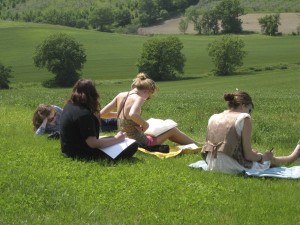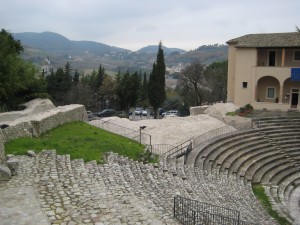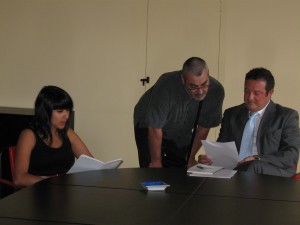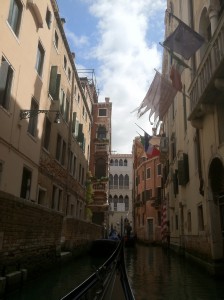Prof. Lott:
“Well. Last day here. We’ll be leaving tomorrow morning at 5:30.
We’ve had a good time here, not only for the food and countryside and people
and history and art, but also because the students have written some very
fine work, and because Professor Rosko and I have witnessed a kind of growth
in their vision and skill and technique that can only be attributed to the
inspiration this place has given them, and to the intensive practice of
writing they have encountered.
But more significant than photos, I believe, are the pieces they have
written while here. At the end of this last post are a couple of examples,
a poem and an excerpt from a long essay, that serve to illustrate the even
clearer and more meaningful windows they have created into their time here
(we will be posting more student work soon). I hope you enjoy them.
Time to pack.
Ciao, e grazie mille.”
——-
Because the Weeds Here Look Just Like Kentucky
by Raena Shirali
this place, more alien than I –
stretched time or sunset forgotten,
and somehow the ache in this gut isn’t one
for a landscape, nor the silver-sided
leaves, lazily waving rows of tilled
and tilling, a green so rich,
shrouded by decrepit bouqueting
like dried brown roses of a lifetime
passed – but more the old man standing
alone on an incline,
less heaving than perched in stillness,
pleated pants and yellowing hands gripping
woodwork cane. his left arm quivers,
veins’ stress shifting underneath paper-pale
skin. it’s more of a pull below the second rib,
a call to open midday-doused eyes,
the gaze of someone left
and left again,
tracing strangers’ silhouettes
in the blaring sun.
The Dirt Road
By Rosanna Hendrix
There’s this winding hill of a dirt road we must climb to get to
the villa. Dust rises at our feet like fog on hot pavement, leaving shoes
powdery gray. Sometimes a car will pass up or down, dust rising higher, a
little wave from the driver. The farther we walk up, the more we can see of
hills and valleys, colored in all shades of green, purple mountains far
away, and the light red-brown roofs of paint-peeled buildings upon the
hills. This is Spoleto.
I’ve never been to Italy, or Europe, and I didn’t think I’d be
going any time soon, but then there was this business about a
three-and-a-half-week study abroad trip at College of Charleston. There
would be creative writing classes and food and free weekends and food and
Spoleto and thirteen students and food, and I was in. We’re staying in a
villa called–according to a map on a wall in our room–Il Pincio Casa
Vacanze, the last two words of which means Holiday House. We’ve taken
weekend trips to Rome, Florence, and Venice, tasted wine in Montefalco,
cooked like we’ve never cooked before right outside Spoleto. And looking
back now–at the end of the trip–I feel I hardly know Spoleto itself,
except for small, insignificant things like the dirt road to the villa.
What’s funny about these small things is they remind me of home.
Maybe it’s the missing of home that does it. I’m not aching to get back, but
I do miss my family and friends, my dog Sadie, my sort-of-boyfriend
boyfriend. I miss my little red car. The Bridge 105.5. The beach. And I
could go for some cheap Tex-Mex. So maybe it’s the missing of home that
allows this faraway place to remind me of where I came from. Or maybe home
is just simply embedded into my memory and always will be. Either way, here
I am, all the way across the big pond, and I hike up this dirt road and
think not just of Spoleto–not even of Charleston, Spoleto’s sister city, my
home for the past six years–but I think of home home.
I grew up in the woods, the midlands of South Carolina, and
there is a dirt path that leads from Robert Hendrix Road (named after my
great grandfather) to home. The path is not nearly as dusty as the one in
Spoleto. Valleys, city, and mountains are replaced by dogwood and pine trees
and yellow grass. There are no curves. The path is flat all the way, about a
sixth of a mile long, and down to the left is the brick house my parents
still live in. But minus the view and the dust and the distance, this path
at home has the same gray rockiness and the same width to it as the dirt
road in Spoleto.
There was always talk from my father of paving the path. It gets
bumpy with rocks and potholes, rainwater settling in puddles. The paving
still hasn’t happened, though. My father just pulls some kind of metal
contraption behind an old red tractor to smooth things out.
My brother, sister, and I used to ride bikes up and down the
path, and when I was ten we started doing the same thing with a bright red
go-cart. Start at one end, floor it, get to the other end, slam brakes, spin
around, go. Later, when the go-cart began to sputter out, we got this old
1980 moped for 100 bucks. The thing was faded red and the seat was big,
black, ripped. It did about 25 up and down that dirt path.
The end of the path, where Robert Hendrix Road starts, was where
we had our mailbox. Every day someone would walk out there–in the rain, the
sun, the snow–to check the mail. The end was where we got off the school
bus too. Our mother would be waiting there for us. And here in Spoleto, when
I’m not even thinking about her or home or anything much, I get to the main
road at the bottom of the path–coming from town or from the villa–and I
almost expect to see her there, waiting.
 This program will take 15 students to Charleston, SC’s sister city of Spoleto, Italy where they will write and study literature and meet with local artists and writers who reside there. The students and faculty will be housed at a villa just outside of Spoleto, where they will share meals, hold readings, and spend quiet time writing and reading. Once a week, the students and faculty will share a special group dinner which will feature intensive and lively discussions of the craft of writing. The program will include cooking classes at Locanda Rovicciana, a tour of area wineries such as Antonelli, day hikes in the Umbrian hills, and museum tours in town; in addition, students will be urged to use their railway passes to travel on the weekends. We will also spend three days in Florence, Italy where students will take guided tours of such important artistic and historical sites as the Uffizi Gallery, the Duomo, and the Galleria dell’Academmia, and spend one evening in salon with an area painter, writer and historian.
This program will take 15 students to Charleston, SC’s sister city of Spoleto, Italy where they will write and study literature and meet with local artists and writers who reside there. The students and faculty will be housed at a villa just outside of Spoleto, where they will share meals, hold readings, and spend quiet time writing and reading. Once a week, the students and faculty will share a special group dinner which will feature intensive and lively discussions of the craft of writing. The program will include cooking classes at Locanda Rovicciana, a tour of area wineries such as Antonelli, day hikes in the Umbrian hills, and museum tours in town; in addition, students will be urged to use their railway passes to travel on the weekends. We will also spend three days in Florence, Italy where students will take guided tours of such important artistic and historical sites as the Uffizi Gallery, the Duomo, and the Galleria dell’Academmia, and spend one evening in salon with an area painter, writer and historian. The Spoleto Valley located in the heart of Umbria is a city rich in history and art. The Arch of Drusus (23 A.C.), the Romanic church of St. Ansano, the Roman theater (its construction goes back to the first years of the Empire), and the paleocristian basilica St Salvatore created in the 4th century are all testimonials of Spoleto’s earliest origins. Take a look at a short video from students who participated in the summer 2010 study abroad program to Spoleto, Italy.
The Spoleto Valley located in the heart of Umbria is a city rich in history and art. The Arch of Drusus (23 A.C.), the Romanic church of St. Ansano, the Roman theater (its construction goes back to the first years of the Empire), and the paleocristian basilica St Salvatore created in the 4th century are all testimonials of Spoleto’s earliest origins. Take a look at a short video from students who participated in the summer 2010 study abroad program to Spoleto, Italy.












